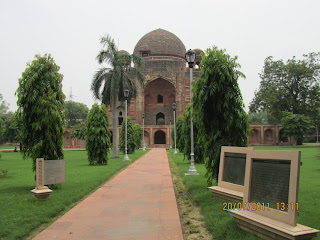Ya rahey hissar* oosar, ya
basey gujjar (May [this place]
remain unoccupied, or else the herdsmen may live here).
I will admit I started
with doubts. Don’t get me wrong, I love to wander around ruins and love seeing
new parts of the city even more. But Shalabh can sometimes be a little over
enthusiastic about history. So when he told my friend Johnny that we were going
off to a far corner of the world to look at a fort with no ceilings, no
complete structures to speak of, surrounded by villages and used as a grazing
ground for the local goats, I felt it was my obligation to explain to Johnny
that he should keep an open mind and just enjoy the metro/auto adventure until
we saw what we were really up against.
The metro ride itself had
to be an hour. It was January of 2011 and the Tuqhlaqabad stop (second to last
stop on the purple line) still had a film of new station dust. After twenty
minutes on a corner, we convinced an auto to take us to
the fort. Feeling generous and desperate, we agreed to pay his way there and
back so he didn’t have to wait for us to finish to pick up another ride. Bumping along, I wondered
if we were leaving the authority of the MCD. Just a bit further and we would be
in Faridabad.
Even after we piled out
onto Mehrauli Bedarpur Road, and I saw the huge walls of the Tughlaqabad Fort looming above us, I was
pretty skeptical. The entrance looked hokey, there were fake stone stairs, an
ASI board, polished towers, and a ticket booth.
The warning signs of an uninteresting afternoon.
I could not have been more
wrong. Three hours later and I was convinced. There is no better way to
appreciate the grand, artistic, spiritual, and destructive history of Delhi
than within the walls of Tughlaqabad. Here is a simply recipe for how you might
spend the day.
1.
Take twenty
minutes when you first enter to sit on a hill and look to the far reaching
walls and the desolate inner grounds of the fort below you. Despite missing
roofs it is easy to conjure up dreams of history and life pacing streets. A grain
grinder looks as if it is waiting for the operator to come back from a long harvest
season. Perhaps it’s because the ghosts of this disserted city were abandoned
here, disconnected from the growth and destruction of Delhi, undisturbed even
now.
 |
| Climbing through secret tunnels. |
2.
Take a walk
with the ghosts. Legend has it that this city is cursed. When Ghiyas-ud-din began
building his fort city, the famous Sufi dervish Nizam-ud-din was completing a
step well for serving the needs of the local people. Although Ghiyas-ud-din
decreed that all craftsmen should be dedicating their time to the fort, many snuck
out at night to volunteer on Nizam-ud-din’s well infuriating the ruler who
already mistrusted and disliked the spiritual leader. During their struggle
Nizam-ud-din proclaimed, Ya rahey hissar, ya basey gujjar (May it
[Tughlaqabad] remain unoccupied, or else the herdsmen may live here).
Whether curse or
prophesy, Nizam-ud-din's words were remarkably accurate. Tughlaqabad, which
took four years to build, was only occupied for six years before a lack of
clean water and the ambition of Ghiyas-ud-Din’s son, Muhammad, forced the
capital to shift to the new city of Jahanpanah.
3.
Get into the walls. I won’t tell you where it is but
somewhere, perhaps a kilometer from the entrance, there is a crawl space in the
fort walls that will lead you outside, and leave you standing on the edge of
fort and forest in what used to be a mighty water way. Perhaps an escape route,
or something less interesting, it is definitely human sized (well, small human
sized). If you find it, keep in mind you will be sharing the crawl space with
bats and the only option once you have reached the other side, is to turn back
around through the tunnel, or scale the fort walls. You don’t need ropes but
you may want to bring a friend. We found it perfectly safe, but promise
nothing.
 |
| Reaching new heights. |
4.
Play a game of tag. Ever since visiting this site I
have a recurring fantasy of playing laser tag or paintball at the fort. Of
course, that is impossible, but a game of simple tag is not. If you steal this
dream from me, tell us tell us how it goes!
If you haven’t figured it out yet, Tughlaqabad is sort of like a giant sandbox. If you can allow
yourself to regress into childlike imagination and restlessness you might just
have the best day you’ve ever had in Delhi.
*Struck through and corrected after the comment by Arghanoon-e-aashiqaan at 05:05 on 24th May 2012


















